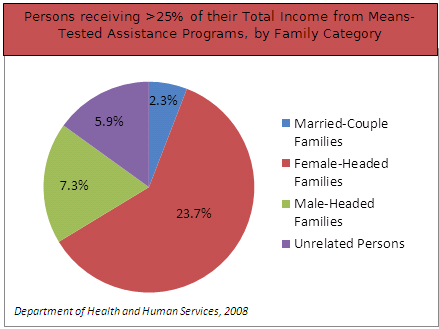Newly elected Republican leadership in the House and Senate
is sure to usher in a wave of policy proposals, reforms, and disputes. A
predictably significant debate already underway is the extent to which policy
will encourage self-sufficiency rather than reliance upon government.
Between 2008 and 2011, household participation in government
benefit programs rose from 45.3 percent to 49.2 percent. However, the majority
of Americans favor independence to reliance on the commons (i.e. government re-distribution). Of those polled, 74 percent believe that
Americans are too dependent on government (87 percent of Republicans and 58
percent of Democrats expressed this view).
Encouragingly, there is a natural, efficient, and generally bipartisan
remedy that will decrease government reliance and encourage self-sufficiency: the
intact, married family. In 2011, federal and state governments spent over $450
billion on means-tested welfare for low-income families with children. Roughly
three-quarters of this welfare assistance, or $330 billion, went to
single-parent families. Notably, three-fourths of all women applying for
welfare benefits do so because of a disruption of marriage.
For most measures of government dependency, family intactness is the leading
influence (or shares the position of leading influence with the fraction of
adult high school graduates). For instance, more adults in their first marriage
(47 percent) have private health insurance than those who have been always
single (23 percent), cohabit (6 percent), have divorced (10 percent), or have
re-married (13 percent).
The influence of family intactness on independence is
readily apparent in the breakdown of welfare recipients by family structure. Family
intactness in a geographic area has the largest influence on average welfare
transfers in that geographic area. This is not surprising because Temporary
Assistance for Needy Families (TANF) primarily supports low-income women and
their children. Only 16 percent of adult women who receive TANF or welfare are
in their first marriage.
The fraction of intact families in a geographic area also
has the largest influence on average Supplemental Security Income (SSI)
transfers to men aged 25 to 54 (with controls applied for demographics,
education, and earnings). Most men who receive Supplemental Security Income
(SSI) have always been single (52 percent) or are divorced (17 percent).
Social science shows that intact families are more self-reliant
and therefore have more options to direct their own lives; however, non-intact
families are at the mercy of the government..
If the new majority will take the longer term view they will
talk up the for parents, pastors and teachers to work to restore marriage in
the nation for there is little that Congress can do to rebuild marriage (though
there is a lot it can do (and has done) to damage marriage. The rebuilding will
be done mainly by other institutions, but encouragement by leaders will be very
helpful.


No comments:
Post a Comment